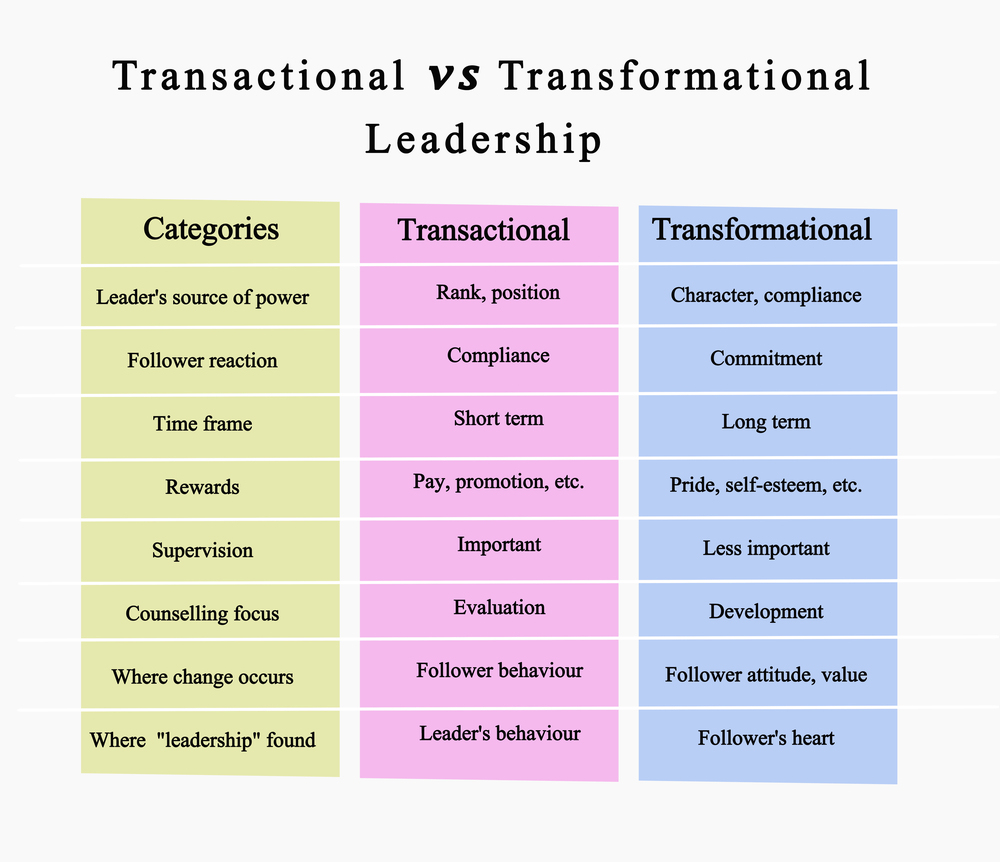In the previous blog What’s Your Leadership Style? Part One, I talked about five major styles of leadership:
- Autocratic
- Democratic/Participative
- Transformational
- Delegative
- Transactional
We looked at Autocratic and its opposite approach, Democratic/Participative leadership styles. This time, in Part Two I’ll describe Transformational, Delegative and Transactional leadership styles.
Transformational Leadership
The transformative leadership style is all about self-development. Transformational leaders create an environment that’s conducive to growth and encourages people both personally and professionally. And they’re not just thinking about their own development, either; they want others to succeed, too.
 This style is all about making everyone feel as though they’re a part of something bigger. Transformational leadership generates a high level of motivation among employees, which creates an atmosphere that’s conducive to success.
This style is all about making everyone feel as though they’re a part of something bigger. Transformational leadership generates a high level of motivation among employees, which creates an atmosphere that’s conducive to success.
Think of some of the biggest disruptors in recent history, especially in business. People like Henry Ford, Bill Gates, Jeff Bezos and Elon Musk are examples of transformational leadership that shattered the status quo, altered or revolutionized industries and even had a significant cultural and societal impact.
Not every business or organization is destined for achievements of that magnitude, but leaders who adopt a transformational approach will help themselves and their employees to think like innovators and encourage ideas and creativity.
For more information about transformational leadership, take a look at Nine Examples of Transformational Leadership in Action from Starting Business.com.
Delegative Leadership
A Delegative leader assigns responsibility to other employees. They run the business but aren’t heavily involved in day-to-day operations or relationships with customers. The CEO puts an idea into action, and managers take it from there, steering it any way they see fit.
 Delegative leadership can be a useful strategy with a team that is skilled and competent, and willing to take on the responsibility that their decision-making power requires. If everyone knows their roles, works well together and has specific areas of the business or tasks they focus on, this kind of delegation can be very effective.
Delegative leadership can be a useful strategy with a team that is skilled and competent, and willing to take on the responsibility that their decision-making power requires. If everyone knows their roles, works well together and has specific areas of the business or tasks they focus on, this kind of delegation can be very effective.
Delegative Leadership works best if the person in the top job sets a strategic direction, wants to try new ideas and approaches, but not be involved in how operations are handled on a daily basis. They don’t have time to micromanage employees all day anyway! Instead of wasting their time on little issues that come up, delegative leadership allows leaders to focus on the big picture while still giving their team direction and freedom to do their jobs.
To learn more about Delegative Leadership, check out Six Examples of Delegative Leadership in Action from Starting Business.com.
Transactional Leadership
A transactional leadership style is a type of leadership that requires people to exchange the performance of certain behaviours for rewards. These leaders focus on developing their employees and helping them grow, but they also keep a close eye on performance and outcomes. They respond quickly if tasks aren’t completed properly or if there’s someone who isn’t pulling his/her/their weight.
Transactional leaders use rewards and punishment as ways of motivating their employees. Positive reinforcement in the form of rewards can encourage certain behaviours. However, transactional leaders can be quick to hand out punishments when employees falter.
Ultimately though, this leadership style is more about carrots than sticks. The transactional leader is constantly encouraging and motivating employees to go above and beyond in order to achieve results, with the hope that employees who feel valued will work harder.
 The main downside of a transactional leadership approach is that it doesn’t work for people who would rather have autonomy in the workplace and can decrease creativity among employees. Additionally, this approach may cause some employees to become disgruntled if they feel that they are not being paid enough for the work that they do. A transactional leadership style that’s focused on “the numbers” may also not allow employees much room to grow.
The main downside of a transactional leadership approach is that it doesn’t work for people who would rather have autonomy in the workplace and can decrease creativity among employees. Additionally, this approach may cause some employees to become disgruntled if they feel that they are not being paid enough for the work that they do. A transactional leadership style that’s focused on “the numbers” may also not allow employees much room to grow.
To learn more about transactional leadership, click here.
Closing Thoughts
Leadership is a tough job, and it’s not for everyone. That’s probably why different types of leadership have evolved over time. The one(s) you choose will depend on the type of person you are and/or the type of organization you’re running.
What works in a creative company probably isn’t the same approach as for a manufacturing facility or warehouse. But if you know which style fits your personality, you can lead in an authentic way that resonates with people, instead of trying to be something or someone you’re not.
So, which one is the right style for you? Above all, it should feel natural and authentic. Pretending to be something you are not is hard to sustain and will take a toll on your energy and mental health.
Do you want to discuss a career, HR, or training-related matter? Reach out today for a free and confidential initial consultation by phone, email, or via direct message on Twitter, Facebook or LinkedIn.
More than career coaching, it’s career psychology®.
I/O Advisory Services Inc. – Building Resilient Careers and Organizations.




